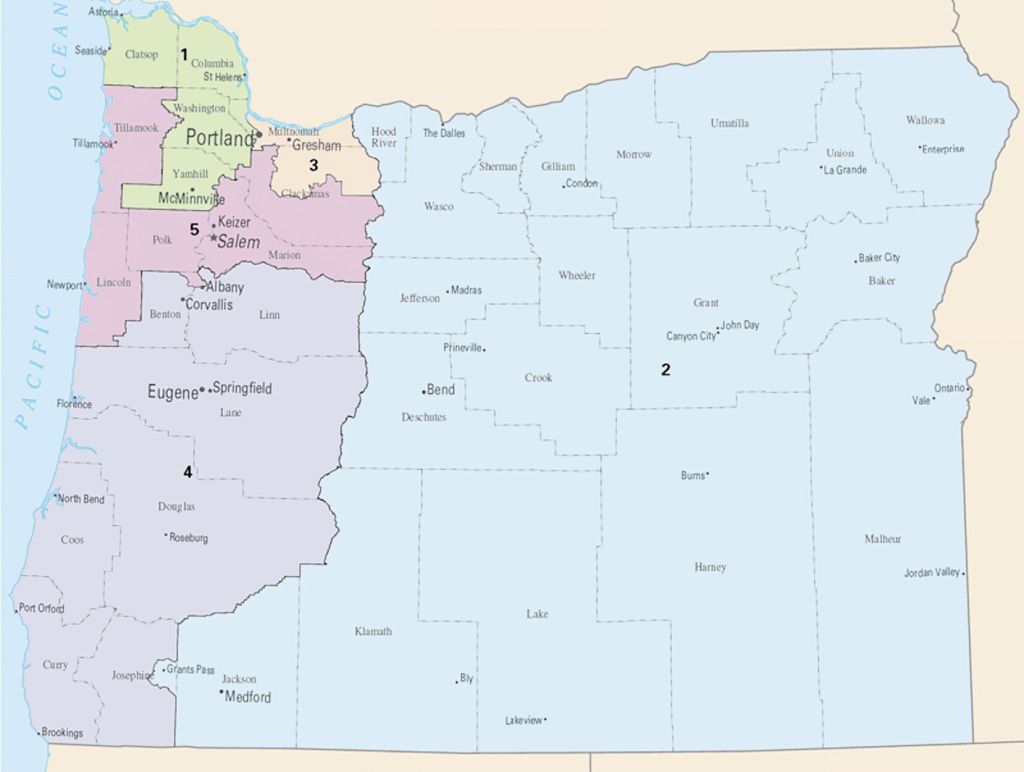No maps? No problem — races for U.S. House seats starting without district lines
Published 10:37 am Friday, July 23, 2021

- Oregon's congressional districts.
The 2022 campaigns for Oregon’s congressional seats have started — despite no maps to tell what part of the state they might represent.
Oregon will have six congressional seats up for grabs on the 2022 ballot — one more than in 2020. But Halloween decorations will be up by the time there is any official inkling of what and who goes where.
The 2020 U.S. Census seized-up under pressure of counting in communities hit by COVID-19. The once-a-decade detailed data the state requires to draw new political maps has always — always — arrived by April 1 of the following year.
Not in this year. Pandemics play hell with politics.
The data is now due Aug. 16.
Oregon doesn’t let candidates file for the 2022 elections until Sept. 9, 2021. By then about all U.S. House candidates will know is they will represent an average of 706,209 people under the 2022 math. But where — north, south, east or west — the throng in each district lives will be still undecided.
Which district should the eager campaigners sign up for? Take a guess.
U.S. Sen. Ron Wyden, D-Oregon, has it easiest. He’s seeking another six-year term in the Senate seat he’s held since 1996. A U.S. Senator represents the whole state — no district border problem then.
But it’s still going to be a crapshoot for all 60 seats in the state House and at least half of the 30 state Senate seats that are up for election. The lines will get scrambled to reflect changes in population and demographics since the last census in 2010. But at least the overall number of seats won’t change.
Not true for Congress. The five U.S. House incumbents for Oregon — four Democrats and one Republican — have started raising money for bids to return to Capitol Hill.
The five will still have to make guesses about how their districts might swell, shrink or stretch because population shifts. Bend and suburban Portland have boomed. Other parts of Eastern and southwest Oregon have not kept pace.
On top of it all, they’ll have to make room for a sixth seat Oregon was awarded in April because of its population increase since 2010 (California lost a seat for the first time in its history).
The late district drawing does come with a calming asterisk for congressional incumbents and hopefuls. Unlike state lawmakers, members of the U.S. House aren’t legally required to live in their districts — just the state.
Willamette Week recently cited a Washington Post story from 2017 reporting 21 of the 435 House members at that time were registered to vote outside their districts.
Candidates for the legislature and Congress face a confusing mix of rules. All must file to vote with the Oregon Secretary of State beginning next month. But both state and federal candidates are free to raise money earlier.
They just have to sign up with different watchdogs.
Legislative campaign financing is handled by the Oregon Secretary of State. The state’s open-ended campaign fundraising laws are legendary around the country. Unlimited money from any single source to any candidate as long as it is reported to the Election’s Division.
Congressional candidates have to raise funds under stricter rules controlled by the Federal Election Commission. The size, though not the number, of contributions is regulated.
Voters for Congress also get an earlier look on who is serious about running.
Despite the state’s official Sept. 9 starting date for filing, the FEC requires a “statement of candidacy” for 2022 fundraising can get started.
When will this mess get fixed? Not this summer.
But when it does, it will be a sprint, not a marathon. The Oregon Supreme Court has the absurdly late census data needed to build district block-by-block will to to Legislatures if and when it arrives Aug. 16. They’ll get the first shot at political mapmaking for 2022.
Expert analysis, public hearings, debate, revisions. a proposal sent to the House and Senate for approval, then on to Gov. Kate Brown for approval or veto.
All in six weeks to do what is normally done in three months.
A special session of the Legislature on Sept. 20 is supposed to ratify the plan. It has to be through the House, Senate and governor’s office in time to be in the laps of the Oregon Supreme Court one week later – Sept. 27
If all goes well, legislative and congressional districts 2022 will be more or less known by the beginning of October.
Unless the Legislature can’t agree.
Or Brown doesn’t approve their work.
Then comes Plan B – and things get even more confusing.
Legislative redistricting would go to Secretary of State Shemia Fagan to draw maps and get them to the court.
But not the U.S. House seats. The Oregon Supreme Court will create a five-member judicial panel with one jurist drawn from each of the five current district.
There are other ifs and buts, deadlines and possible delays from court challenges.
But the bottom-line goal is for the drawing, squabbling, and court challenges to be done with time to spare before the March 8 deadline for candidates to file for office.
The quicker the maps are finished, the longer that candidates and voters will get a chance to figure out who and what and where they are voting for in the May 27 primary.
by early next year. Enough time for candidates to know where they are running and voters to know who they are voting for before the May 22, 2022 primary. voters and candidates know who is running for what and where.
That circles back around to the campaign finance reporting split. Candidates for state offices usually have to report contributions within 30 days of receipt.
Back to campaign financing: Candidates for state office have to regularly report how much they have raised and spent – usually within 30 days, but close to election time, it’s 7 days.
Congress reports four times a year – once every three months. The latest report came in June 30. The filings say who is running, how much they raised this year, how much they spent, plus “cash on hand.” The latter figure can often be the largest because it money that incumbents – are challengers who are making back-to-back bids, roll over from their last campaigns.
The latest FEC report is a very, very early snapshot of who is in, who is out, who has money, who is spending. There will likely be dozens more candidates and surely millions more dollars. And remember, that doesn’t county the outside spending by outside groups that is harder to regulate.
What’s known so far:
United States House of Representatives
Six seats up for two-year terms, including an extra seat since redistricting after the 2010 census. District boundaries TBD. Partisan split is four Democrats and one Republican. Base salary: $174,000.
1st Congressional District
U.S. Rep. Susan Bonamici, D-Beaverton
Bonamici, is seeking re-election to the seat she first won in 2012. A native of Detroit, she served in the Oregon House and Senate prior to moving to Congress.
Money raised: $229,116.81
Money spent: $170,923.28
Cash on hand: $611,539.31
David Russ, Republican
Russ has filed a report as a Republican running for the CD1 seat. His “David Russ is for Us” PAC lists a Dundee, Oregon address.
Raised: $1,142.76
Spent: $768.90
On Hand: $579.24
2nd Congressional District
U.S. Rep. Cliff Bentz, R-Ontario
Bentz is gearing up for his first re-election bid since winning the seat in 2020. A former state lawmaker, Bentz replaced retiring Rep. Greg Walden, R-Hood River, who had held the seat for two decades.
Raised: $150,021.51
Spent: $74,336.01
On hand: $164,739.19
Raiph R. Huber, Republican
Huber has filed a report as a Republican in the CD2 race. His report shows no financial activity. Huber’s committee lists a Springfield contact address.
3rd Congressional District
U.S. Rep. Earl Blumenauer, D-Portland
Blumenauer is currently the only candidate currently listed with a committee for the district centered in Portland. Blumenauer was elected to the state House in 1972, and later served on the Multnomah County Board of Commissioners and Portland City Council. Elected to Congress in 1996, he took the seat held by U.S. Sen. Ron Wyden, D-Oregon, who was elected to the U.S. Senate.
Raised: $270,660.39
Spent: $223,222.54
On hand: $804,782.65
4th Congressional District
U.S. Rep. Peter DeFazio, D-Springfield
The dean of the Oregon U.S. House delegation, DeFazio was a Lane County commissioner before winning election to the U.S. House race in 1986. He’s been elected 17 staight times. DeFazio lost the 1995 special election to the U.S. Senate won by current U.S. Sen. Ron Wyden, D-Oregon. After frequently winning reelection with 60% of the vote until 2010, reapportionment has made the district more competitive since 2012.
Raised: $920,528.82
Spent: $271,500.04
On hand: $1,166,623.92
Alek Skarlatos, Republican
The Roseburg political activist who won fame for his part in subduing a terrorist attack on a Paris-bound train in 2015, Skarlatos is seeking a rematch. DeFazio won 51.5% of the vote to 46.2% for Skarlatos in 2020. Skarlatos lost a close 2018 bid for Douglas County commissioner.
Raised: $229,167.17
Spent: $135,738.14
On hand: $216,785.58
Jeremy Van Tress, Republican
Van Tress’s website lists him as an 11-year U.S. Army veteran with a PhD in clinic social work. He lives in Corvallis
Raised: $39,195.00
Spent: $9,033.92
On hand: $30,161.08
5th Congressional District
U.S. Rep. Kurt Schrader, D-Salem
The former state legislator was first elected to the U.S. House in 2008. Schrader’s district is considered the most difficult for a Democrat to win, with Republicans and minor party candidates have kept Schrader’s six re-election victory margins at no more than 55%. Schrader has been rated by the non-partisan McCourt Center of Public Policy as Oregon’s most moderate lawmakers. The district partisan split and Schrader’s votes and comments are a reason he is drawing a large field of challengers for 2022.
Raised: $395,232.54
Spent: $131,684.17
On hand: $2,780,047.56
Mark Gamba, Democrat
The Milwaukie mayor was runner-up in the 2020 Democratic primary against Schrader, Gamba received 22.9% of the vote.
Raised: $810.00
Spent: $5,135.28
On hand: $10,632.80
Kevin Easton, Democrat
Easton has filed a committee with the FEC but has no transactions to date.
Amy Ryan Courser, Republican
Courser, a Keizer resident, is seeking a rematch with Schrader. The Republican nominee for the 5th district race in 2020, Courser lost to Schrader 51.9% to 45.2%. In the earlier race, she received endorsements from anti-abortion and anti-gun control groups.
Raised: $44,854.24
Spent: $36,742.40
On hand: $18,582.73
Lori Chavez-DeRemer, Republican
The former Happy Valley mayor jumped into the 5th district race right at the SEC filing deadline, but is expected to have significant financial support. She considered a 2018 bid for governor, but did not run.
Created a campaign finance committee — no transactions.
Nate Sandvig, Republican
A resident of Neskowin on the coast, Sandvig’s campaign materials list him as a West Point graduate and U.S. Army veteran who works in the renewable energy field.
Raised: $114,116.67
Spent: $4,198.66
On hand: $109,918.01
6th Congressional District
The “Where’s Waldo” of Oregon’s political map, the locations of the new district won’t likely be known until just before October at the earliest.
Along with the governor’s seat, the 6th Congressional District seat will be one a rare political plum: A top office with no incumbent. On average, one of the Oregon U.S. House seats has come up once a decade since 1986.
The chance to nail down a U.S. House seat at the beginning will likely draw a bumper crop of candidates — more so when the boundaries and political hue of the district are made clear.
Former Multnomah County Commissioner Loretta Smith and Derry Al Jackson Sr. of Portland as having filed statements of candidacy with the FEC for “OR6” — though no link to an actual district is ont he website. Again, House members do not have to be a resident of their district – just of the state.
U.S. Senate
Senators are elected for six-year terms staggered across three different “classes.” This year is the turn of the 34-member group that includes the seat currently held by U.S. Sen. Ron Wyden, D-Oregon. with about one-third up for election each two years.
U.S. Sen. Ron Wyden, Democrat
Wyden is seeking a new six-year term to the U.S. Senate seat since 1996, when he replaced Sen. Ron Packwood, R-Oregon, who resigned. Wyden had served in the U.S. House since winning election in 1980 to the 2nd Congressional District seat that includes Portland. Wyden is the longest-serving lawmaker in the Oregon delegation.
Raised: $6,734,663.56
Spent: $5,331,597.81
On hand: $4,801,356.83
Jo Rae Perkins, Republican
The Albany resident won the 2020 Republican nomination to face Merkley. She won 39.3% of the vote. Perkins had unsuccessfully run for the Republican nomination against Merkley in 2014 and to run against U.S. Rep. Peter DeFazio in 2010.
Raised: $745.21
Spent: $6,589.69
On hand: $0.00
Rodney Jason Beebe, Republican
Raised: $300.00
Spent: $12.60
On hand: $287.40
William Edward Barlow III, Republican
Barlow has registered a committee with the SEC but reported no transactions.
Thomas X. Verde, Unaffiliated
Verde has registered a committee but shows no transactions.





